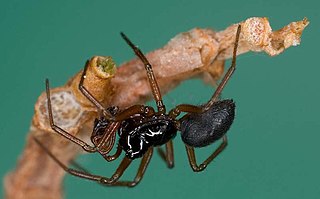
Linyphiidae, spiders commonly known as sheet weavers, or money spiders is a family of very small spiders comprising 4706 described species in 620 genera worldwide. This makes Linyphiidae the second largest family of spiders after the Salticidae. The family is poorly understood due to their small body size and wide distribution, new genera and species are still being discovered throughout the world. The newest such genus is Himalafurca from Nepal, formally described in April 2021 by Tanasevitch. Since it is so difficult to identify such tiny spiders, there are regular changes in taxonomy as species are combined or divided.

Cheiracanthium, commonly called yellow sac spiders, is a genus of araneomorph spiders in the family Cheiracanthiidae, and was first described by Carl Ludwig Koch in 1839. They are usually pale in colour, and have an abdomen that can range from yellow to beige. Both sexes range in size from 5 to 10 millimetres. They are unique among common house spiders because their tarsi do not point either outward, like members of Tegenaria, or inward, like members of Araneus), making them easier to identify. The name is a reference to the backwardly directed process on the cymbium of the male palp. The species epithet is derived from the Greek Ancient Greek: χείρ, romanized: cheir, meaning "hand", and Acanthium, a genus of thorny-stemmed plants.

Atypus, also called purseweb spiders, is a genus of atypical tarantulas first described by Pierre André Latreille in 1804. It occurs in Eurasia, with one species reaching into North Africa, and one species in the USA. Only three of the described species occur in Europe: A. piceus, A. affinis, and A. muralis.

Neriene is a genus of sheet weavers that was first described by John Blackwall in 1833.

Clubiona is a genus of sac spiders that was first described by Pierre André Latreille in 1804.

Hylyphantes graminicola is a small linyphiid spider with palaearctic distribution. It is one of the most important natural enemies of different pests in farmland and forests in Asia. In cotton fields, it was found to build a small web between clods of young plants, and to live on branches when the plant gets bigger. Up to 30 individuals per square meter were found in cotton fields of northern China.

Parasteatoda is a genus of comb-footed spiders that was first described by Allan Frost Archer in 1946. The name is a combination of the Ancient Greek "para-" (παρά), meaning "near" or "next to", and the theridiid genus Steatoda. The Japanese name for this genus is O-himogumo zoku.

Anahita is a genus of wandering spiders first described by Ferdinand Karsch in 1879.

Walckenaeria is a genus of dwarf spiders that was first described by John Blackwall in 1833. It is a senior synonym of Paragonatium, as well as Wideria, Cornicularia, Prosopotheca, Tigellinus, and Trachynella.

Erigone is a genus of dwarf spiders that was first described by Jean Victoire Audouin in 1826. They are carnivorous, preying on small insects such as psylla and flies. One of the distinctive characters for this genus is the presence of teeth bordering the carapace.

Bathyphantes is a genus of dwarf spiders that was first described by Anton Menge in 1866.

Nematogmus is a genus of dwarf spiders that was first described by Eugène Louis Simon in 1884.
Dactylopisthes is a genus of dwarf spiders that was first described by Eugène Louis Simon in 1884.

Entelecara is a genus of dwarf spiders that was first described by Eugène Louis Simon in 1884.
Gongylidiellum is a genus of dwarf spiders that was first described by Eugène Louis Simon in 1884.

Gongylidioides is a genus of Asian dwarf spiders that was first described by R. Oi in 1960.
Nasoona is a genus of dwarf spiders that was first described by G. H. Locket in 1982.

Phycosoma is a genus of comb-footed spiders that was first described by Octavius Pickard-Cambridge in 1880.

Rhomphaea is a genus of comb-footed spiders that was first described by Ludwig Carl Christian Koch in 1872.
Collinsia is a genus of dwarf spiders that was first described by Octavius Pickard-Cambridge in 1913.
















